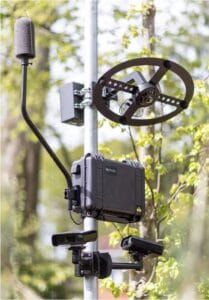An inventor has told how a collision with a cyclist on his first ever driving lesson 40 years ago, made a lasting impression on him, and led to him creating a life-saving road safety solution.
Nobody was physically harmed in the crash, but Jock Boyle says he will never forget the sight of the cyclist’s face against the car window as he turned into a junction across the bike’s path.
“I didn’t see the cyclist because of the blind spot. I’ve carried that with me all of these years. As a driver, every time I’ve approached a junction or turned a corner since that day, it’s the first thing that comes to my mind. It’s a lesson I’ll never forget” said the 58-year-old.
Jock, from Edinburgh, had been learning to drive in Berlin, during his time in the Army, while serving with Black Watch.
So affected by what happened that day, and so aware of how lucky the cyclist was to have avoided injury, he spent many years researching the dangers of blind spots and began developing his own solutions to protect these vulnerable road users.
Jock carried out his own experiments in cars and HGVs, using a variety of measures, to see which were most effective in increasing drivers’ visibility.
Government figures have consistently shown that the most common contributory factor in collisions in which cyclists were killed or seriously injured, was ‘driver or rider failed to look properly.’*
But, as Jock knew only too well, many of these drivers probably did look properly, but they just had no way of seeing the cyclists if they happened to be in one of their blind spots.
Generally, car drivers have two main blind spots on either side of the vehicle, while HGV drivers have four areas of limited visibility – at the front, rear and each side.
In 2022, the Government’s casualty data also showed that the highest proportion of cyclist deaths occurred in two vehicle collisions involving an HGV (6.2%).
“Vehicles that have the least amount of visibility are causing the greatest amount of fatalities,” said Jock.
“Drivers can’t give priority, avoid or react to people that they can’t see.”
Many manufacturers claim that technology is key in increasing driver visibility and preventing sideswipe collisions, and many vehicles now have blind spot cameras installed as standard.
But as drivers, our over-reliance on technology to be safe and competent, can have detrimental effects on our behaviour behind the wheel. We have become too comfortable and too confident in our ability, using technology as our crutch, and we are getting out of the habit of using our own senses to control a vehicle.
Blind spot cameras simply add to the plethora of safety technology features in our vehicles, and we are being taken further away from the driver we were trained to be when we first passed our test.
Relying on technology is also a much more costly solution, especially for fleets.
Fresnel lenses have been used for years to increase drivers’ visibility, particularly in left-hand drive HGVs, which are involved in a disproportionately high number of reported ‘side-swipe’ incidents.
The lenses have long been known to increase visibility by 30 degrees, allowing the driver to see into the area obscured by the vehicle door and body.
A project conducted by the Vehicle and Operator Services Agency (VOSA) some years ago, involved supplying 40,000 Fresnel lenses to drivers during a period of three weeks at three French ports, through which the majority of HGVs enter the UK.
As a result, left-hand drive side-swiping incidents decreased by 59% – from 26 per week before the lenses were distributed, to an average of 11. And in 91% of left-hand side-swiping incidents, the HGVs did not have a lens fitted.**
Jock realised that these lenses should be used widely in the UK by commercial drivers and he made it his mission to ensure this happened.
Jock eventually developed Viz- Ovalz® Direct Vizion System- a new and improved retrofittable Fresnel lens that:
- Is easily attached by a removable sucker to vehicle windscreens and windows
- Can be easily adjusted and tilted to suit every driver and vehicle.
– Expands a driver’s peripheral field of view overall by 60 degrees (30 left and 30 right)
At just £30 plus VAT, per lens, Viz -Ovalz is far more cost effective than blind spot cameras and other technology, making it the ideal safety enhancement for fleets of all sizes.
The lenses also align to the Transport for London (TfL) Direct Vision Standard, launched in 2021 to improve drivers’ direct vision through the cab windows of HGVs and prevent collisions caused by limited visibility.
The Direct Vision Standard measures how much an HGV driver can see directly through their cab windows. This indicates the level of risk to vulnerable road users, such as people walking and cycling, near the vehicle.
Viz-Ovalz can be quickly and easily fixed to the inside the vehicle windows and works with the driver to enhance their field of view.
This is quicker and comes more naturally for a driver than viewing a camera, ensuring quicker reaction times and increasing the driver’s sense of control.
Jock added: “There is a lot of pressure on commercial fleets to be the safest they can be, and that often comes with a significant financial cost.
“But compared to the latest blind spot cameras and other safety technology, Viz Ovalz® is a very small fraction of the price and is an affordable option for entire fleets.
“The lenses will give fleet managers and business owners peace of mind that they have done everything in their power to reduce blind spot collisions, and drivers can do their job with confidence, knowing that they have a maximum view of the road.”
(Picture – RoadPeace)


























